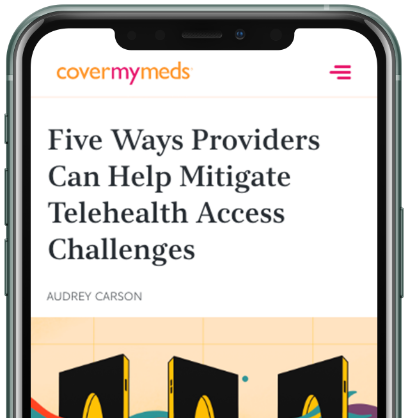How Technology Can Help Your Office Crisis-Proof Chronic Care
During a crisis, healthcare technology can be a vital lifeline between providers and their chronic care patients. Whether it’s a pandemic, natural disaster or a personal crisis, providers can connect with and treat patients with chronic conditions using technology like telehealth, digital HUBs and real-time data integrated in workflow.

When dealing with a crisis as overwhelming as the COVID-19 pandemic, healthcare providers faced many challenges that profoundly affected how they treated their patients, especially those with chronic conditions. Office visits normally used for checkups or administering complex specialty medications were significantly limited or eliminated altogether.
While the pandemic was and still is an extreme situation, this kind of chronic condition treatment disruption can also be affected by natural disasters, personal or existential crises and financial issues brought on by job and/or insurance loss.
Patients with chronic conditions are among the most vulnerable to disruptions in treatment in times of crisis. Below, we’ll discuss how providers and chronic care patients can be more prepared during a crisis.
How do crises affect providers’ ability to deliver chronic care?
The COVID-19 pandemic placed considerable strain on healthcare providers. When the pandemic made office visits difficult or unavailable, many providers turned to telehealth to treat patients, but for some chronic conditions, those efforts were unlikely to help. Take diabetes, for example, a condition that requires regular blood work done in the office, something telehealth can’t easily solve.
Even when office visits are available, many patients with chronic conditions are still wary of going to see their provider. In a 2020 report, about half of patients surveyed with chronic conditions said they were worried about visiting their provider for a non-coronavirus healthcare need. Ten percent of those respondents said they were so concerned that they would forego care altogether.COVID-19 Pulse: Delivering regular insights on the pandemic from a 150,000+ person connected cohort, evidation, 2020
How are chronic care patients affected by crises?
In a recent survey of chronically ill and immunocompromised patients, 69 percent reported at least some difficulty managing their conditions during the pandemic.Docs could face looming health crisis as COVID-19 disrupts care for chronically ill, Fierce Healthcare, 2020 They were also concerned about being able to afford their medications after being furloughed or laid off.
One diabetes patient in the survey said he was stretching his insulin and other diabetic supplies because of concerns about being able to afford copays after losing work hours due to the pandemic. Only 38 percent said they felt prepared to deal with their health during the COVID-19 pandemic and 58 percent said they worried about losing access to essential treatments.
69% of chronically ill and immunocompromised patients reported at least some difficulty managing their conditions during the pandemic.
Fierce Healthcare"Docs could face looming health crisis as COVID-19 disrupts care for chronically ill," April 16, 2020
How important is technology in helping with crisis preparedness?
Having the right technology in place is a crucial element that can help providers maintain contact with and treat patients during a crisis.
In addition to hospitals and emergency responders, providers need real-time access to data regarding available healthcare resources that affect treatment for their patients, especially those with chronic conditions.
During the pandemic, office visits weren’t always an option for chronic care patients for many reasons, including their extreme vulnerability to the COVID-19 infection. That’s where technology like telehealth became an indispensable resource for providers in treating some but not all their patients with chronic conditions.
What challenges do chronic care patients in underserved communities face during a crisis like the COVID-19 pandemic?
Due to many factors, including the lack of health insurance and accessible community health facilities, the pandemic affected underserved communities in ways not experienced in other communities.The Impact of Underserved Communities in Times of Crisis, HIMSS, 2020 Without adequate access to COVID testing, vaccination, and medical care, chronic care patients in underserved communities are more at risk from crises like the pandemic.
This is another area where telehealth becomes a vital lifeline.
While many of those living in poverty don’t have access to a computer, the majority do have a smartphone.Digital divide persists even as Americans with lower incomes make gains in tech adoption, Pew Research Center, 2021 This can allow patients with chronic conditions to continue getting care when regular office visits aren’t possible due to overburdened facilities caring for those sick with COVID-19.
How can providers help chronic condition patients with affordability?
When a crisis like a pandemic happens, patients faced with financial burdens from loss of a job and insurance may not adhere to their medications.
Providers can help their chronic care patients by introducing them to financial solutions like manufacturer copay cards that reduce or even eliminate the costs of specialty medications. Other technology solutions that are embedded in the provider’s workflow can also help identify other medications that are more affordable.
What can providers do to help maintain chronic care during a crisis?
In addition to telehealth and enrolling patients in a hub, providers can also introduce patients with chronic conditions to behavioral coaching, which pairs them with a patient support specialist trained in all aspects of adherence.
Connecting behavioral coaches via telehealth and smartphones to chronic care patients who can’t make office visits also applies here. Using available technology solutions, like remote monitoring, can also help providers treat their chronic care patients.
Learn more about technological solutions that can help with crisis-proof providers’ offices
By incorporating real-time benefits solutions into your workflow, enrolling your chronic care patients in a tech-enabled hub, using telehealth to stay connected and embracing other technology solutions as they’re made available, providers can help ensure their patients with chronic conditions get the care they need during crises.
For more information, download the 2021 CoverMyMeds Medication Access Report: Healthcare Technology edition
The latest healthcare insights, floated right to your inbox.





